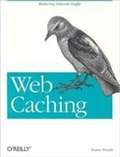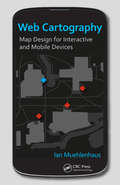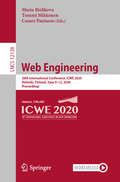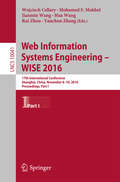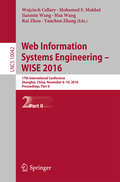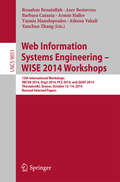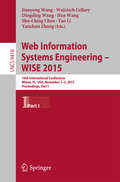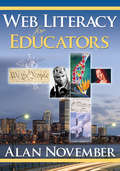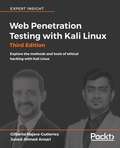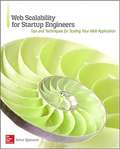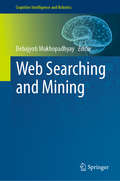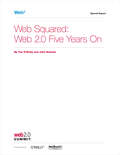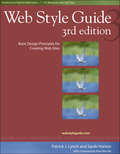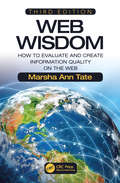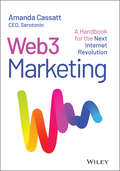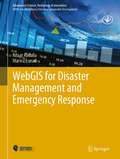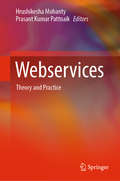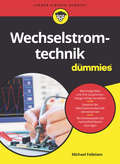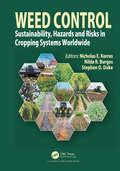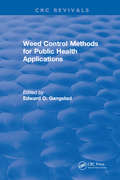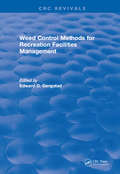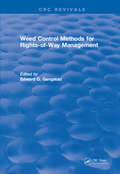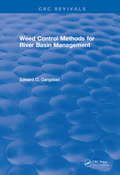- Table View
- List View
Web Caching
by Duane WesselsA properly designed web cache, by reducing network traffic and improving access times to popular web sites, is a boon to network administrators and web users alike. This book hands you all the technical information you need to design, deploy, and operate an effective web caching service. It also covers the important political aspects of web caching, including privacy and security issues.
Web Cartography: Map Design for Interactive and Mobile Devices
by Ian MuehlenhausWeb mapping technologies continue to evolve at an incredible pace. Technology is but one facet of web map creation, however. Map design, aesthetics, and user-interactivity are equally important for effective map communication. From interactivity to graphical user interface design, from symbolization choices to animation, and from layout to typeface
Web Engineering: 20th International Conference, ICWE 2020, Helsinki, Finland, June 9–12, 2020, Proceedings (Lecture Notes in Computer Science #12128)
by Cesare Pautasso Tommi Mikkonen Maria BielikovaThis book constitutes the proceedings of the 20th International Conference on Web Engineering, ICWE 2020, which was planned to take place in Helsinki, Finland, during June 9-12, 2020. Due to the corona pandemic the conference changed to a virtual format. The total of 24 full and 10 short contributions presented in this volume were carefully reviewed and selected from 78 submissions. The book also contains 4 PhD and 7 demo papers. The papers were organized in topical sections named: User interface technologies; performance of Web technologies; machine learning; testing of Web applications; emotion detection; location-aware applications; sentiment analysis; open data; liquid Web applications; Web-based learning; PhD symposium; demos and posters.
Web Information Systems Engineering – WISE 2016
by Wojciech Cellary Mohamed F. Mokbel Jianmin Wang Hua Wang Rui Zhou Yanchun ZhangThis two volume set LNCS 10041 and LNCS 10042 constitutes the proceedings of the 17th International Conference on Web Information Systems Engineering, WISE 2016, held in Shanghai, China, in November 2016. The 39 full papers and 31 short papers presented in these proceedings were carefully reviewed and selected from 233 submissions. The papers cover a wide range of topics such as Social Network Data Analysis; Recommender Systems; Topic Modeling; Data Diversity; Data Similarity; Context-Aware Recommendation; Prediction; Big Data Processing; Cloud Computing; Event Detection; Data Mining; Sentiment Analysis; Ranking in Social Networks; Microblog Data Analysis; Query Processing; Spatial and Temporal Data; Graph Theory; Non-Traditional Environments; and Special Session on Data Quality and Trust in Big Data.
Web Information Systems Engineering – WISE 2016
by Wojciech Cellary Mohamed F. Mokbel Jianmin Wang Hua Wang Rui Zhou Yanchun ZhangThis two volume set LNCS 10041 and LNCS 10042 constitutes the proceedings of the 17th International Conference on Web Information Systems Engineering, WISE 2016, held in Shanghai, China, in November 2016. The 39 full papers and 31 short papers presented in these proceedings were carefully reviewed and selected from 233 submissions. The papers cover a wide range of topics such as Social Network Data Analysis; Recommender Systems; Topic Modeling; Data Diversity; Data Similarity; Context-Aware Recommendation; Prediction; Big Data Processing; Cloud Computing; Event Detection; Data Mining; Sentiment Analysis; Ranking in Social Networks; Microblog Data Analysis; Query Processing; Spatial and Temporal Data; Graph Theory; Non-Traditional Environments; and Special Session on Data Quality and Trust in Big Data.
Web Information Systems Engineering - WISE 2014 Workshops
by Boualem Benatallah Azer Bestavros Barbara Catania Armin Haller Yannis Manolopoulos Athena Vakali Yanchun ZhangThis book constitutes the revised selected papers of the combined workshops on Web Information Systems Engineering, WISE 2014, held in Thessaloniki, Greece, in October 2014. The 19 selected papers presented were carefully revised and report from the four workshops: computational social networks, IWCSN 2014, enterprise social networks, Org2 2014, personalization and context-awareness in cloud and service computing, PCS 2014, and data quality and trust in big data, QUAT 2014.
Web Information Systems Engineering - WISE 2015
by Yanchun Zhang Tao Li Shu-Ching Chen Hua Wang Dingding Wang Wojciech Cellary Jianyong WangThis two volume set LNCS 9418 and LNCS 9419 constitutes the proceedings of the 16th International Conference on Web Information Systems Engineering, WISE 2015, held in Miami, FL, USA, in November 2015. The 53 full papers, 17 short and 14 special sessions and invited papers, presented in these proceedings were carefully reviewed and selected from 189 submissions. The papers cover the areas of big data techniques and applications, deep/hidden web, integration of web and internet, linked open data, semantic web, social network computing, social web and applications, social web models, analysis and mining, web-based applications, web-based business processes and web services, web data integration and mashups, web data models, web information retrieval, web privacy and security, web-based recommendations, and web search.
Web Literacy for Educators
by Alan C. NovemberThe author offers exercises, examples, handouts, and basic tips to help both learners and educators find and evaluate information on the Web for quality and validity.
Web Marketing for the Music Business
by Tom HutchisonInterested in promoting, selling, and distributing music online? Have the website but not sure what to do next? Web Marketing for the Music Business is designed to help develop the essential Internet presence needed for effective promotion, sales, and distribution. Author Tom Hutchison provides instructions on how to set up a website, as well as how to use the Internet to promote you or your client, and the website. Includes information on maximizing your site to increase traffic, online grassroots marketing tactics that will advance your career and how to best utilize social networking sites such as Facebook and Twitter. The accompanying website will keep you up-to-date, with online resources for web support. The author's blog is continuously updated to include the latest breaking techniques for promotion.
Web Penetration Testing with Kali Linux (Third Edition): Explore the methods and tools of ethical hacking with Kali Linux
by Gilberto Nájera-Gutiérrez Juned Ahmed AnsariBuild your defense against web attacks with Kali Linux, including command injection flaws, crypto implementation layers, and web application security holes Key Features - Know how to set up your lab with Kali Linux - Discover the core concepts of web penetration testing - Get the tools and techniques you need with Kali Linux Book Description Web Penetration Testing with Kali Linux - Third Edition shows you how to set up a lab, helps you understand the nature and mechanics of attacking websites, and explains classical attacks in great depth. This edition is heavily updated for the latest Kali Linux changes and the most recent attacks. Kali Linux shines when it comes to client-side attacks and fuzzing in particular. From the start of the book, you'll be given a thorough grounding in the concepts of hacking and penetration testing, and you'll see the tools used in Kali Linux that relate to web application hacking. You'll gain a deep understanding of classicalSQL, command-injection flaws, and the many ways to exploit these flaws. Web penetration testing also needs a general overview of client-side attacks, which is rounded out by a long discussion of scripting and input validation flaws. There is also an important chapter on cryptographic implementation flaws, where we discuss the most recent problems with cryptographic layers in the networking stack. The importance of these attacks cannot be overstated, and defending against them is relevant to most internet users and, of course, penetration testers. At the end of the book, you'll use an automated technique called fuzzing to identify flaws in a web application. Finally, you'll gain an understanding of web application vulnerabilities and the ways they can be exploited using the tools in Kali Linux. What you will learn Learn how to set up your lab with Kali Linux Understand the core concepts of web penetration testing Get to know the tools and techniques you need to use with Kali Linux Identify the difference between hacking a web application and network hacking Expose vulnerabilities present in web servers and their applications using server-side attacks Understand the different techniques used to identify the flavor of web applications See standard attacks such as exploiting cross-site request forgery and cross-site scripting flaws Get an overview of the art of client-side attacks Explore automated attacks such as fuzzing web applicationsWho this book is for Since this book sets out to cover a large number of tools and security fields, it can work as an introduction to practical security skills for beginners in security. In addition, web programmers and also system administrators would benefit from this rigorous introduction to web penetration testing. Basic system administration skills are necessary, and the ability to read code is a must.
Web Scalability for Startup Engineers
by Artur EjsmontThis is an invaluable roadmap for meeting the rapid demand to deliver scalable applications in a startup environment. With a focus on core concepts and best practices rather than on individual languages, platforms, or technologies, Web Scalability for Startup Engineers describes how infrastructure and software architecture work together to support a scalable environment. <p><p> You’ll learn, step by step, how scalable systems work and how to solve common challenges. Helpful diagrams are included throughout, and real-world examples illustrate the concepts presented. Even if you have limited time and resources, you can successfully develop and deliver robust, scalable web applications with help from this practical guide. <p><p> Learn the key principles of good software design required for scalable systems Build the front-end layer to sustain the highest levels of concurrency and request rates Design and develop web services, including REST-ful APIs; Enable a horizontally scalable data layer Implement caching best practices; Leverage asynchronous processing, messaging, and event-driven architecture; Structure, index, and store data for optimized search; Explore other aspects of scalability, such as automation, project management, and agile teams.
Web Searching and Mining (Cognitive Intelligence And Robotics)
by Debajyoti MukhopadhyayThis book presents the basics of search engines and their components. It introduces, for the first time, the concept of Cellular Automata in Web technology and discusses the prerequisites of Cellular Automata. In today’s world, searching data from the World Wide Web is a common phenomenon for virtually everyone. It is also a fact that searching the tremendous amount of data from the Internet is a mammoth task – and handling the data after retrieval is even more challenging. In this context, it is important to understand the need for space efficiency in data storage. Though Cellular Automata has been utilized earlier in many fields, in this book the authors experiment with employing its strong mathematical model to address some critical issues in the field of Web Mining.
Web Squared: Web 2.0 Five Years On
by John Battelle Tim O'ReillyEver since we first introduced the term Web 2.0, people have been asking, What's next? Assuming that Web 2.0 was meant to be a kind of software version number (rather than a statement about the second coming of the Web after the dotcom bust), we're constantly asked about Web 3.0. Is it the semantic web? The sentient web? Is it the social web? The mobile web? Is it some form of virtual reality? It is all of those, and more. The Web is no longer a collection of static pages of HTML that describe something in the world. Increasingly, the Web is the world "everything and everyone in the world casts an information shadow, an aura of data which, when captured and processed intelligently, offers extraordinary opportunity and mindbending implications. Web Squared is our way of exploring this phenomenon and giving it a name.
Web Style Guide
by Patrick J. LynchThis essential guide for Web site designers offers clear, concise advice on creating well-designed and effective Web sites and pages. Focusing on the interface and graphic design principles that underlie the best Web site design, the book provides anyone involved with Web site design -- in corporations, government, nonprofit organizations, and academic institutions -- with expert guidance on issues ranging from planning and organizing goals to design strategies for a site to the elements of individual page design. Shifting away from the emphasis of many authors on HyperText Markup Language (HTML) and glitzy, gimmicky graphics, Patrick J. Lynch and Sarah Horton discuss classic principles of design, how these principles apply to Web design, and the issues and constraints of designing complex, multilayered sites. They address the practical concerns of bending and adapting HTML to the purposes of graphic page design. This book grew out of the widely used and highly praised Web site on site designcreated by,the Center for Advanced Instructional Media at Yale University (info. med. yale. ed/ cairn/manual/). At this site, readers will continue to find updated color illustrations and examples to complement and demonstrate points made in the book, as well as useful and current online references.
Web Wisdom: How to Evaluate and Create Information Quality on the Web, Third Edition
by Marsha Ann TateThe World Wide Web has undergone tremendous growth since the first edition of Web Wisdom: How to Evaluate and Create Information Quality on the Web was conceived and written in the mid to late 1990s. The phenomenal global expansion of the internet, together with the increasing sophistication of online technologies and software applications, requires us to be more savvy Web users, especially given the growing complexity of Web-based information. This new edition of Web Wisdom covers key issues that users and creators of Web resources need to know regarding reliable and useful information on the Web, including social media content. Written in a straightforward and accessible format, the book also provides critical evaluation techniques and tools to enhance Web-based research and the creation of high quality content. Features Includes checklists comprised of basic questions to ask when evaluating or creating web resources Provides an expanded discussion of copyright, trademark, and other related issues with specific reference to web authoring Contains a chapter devoted exclusively to social media applications and their unique evaluation challenges Presents a new section that addresses the evaluation challenges that are related to combining traditional and social media content Offers a new section focused on computer-generated text and its allied evaluation challenges Introduces a revised and expanded companion website that provides a variety of supplemental materials related to the evaluation and creation of web content as well as links to additional examples This book demonstrates how to adapt and apply the five core traditional evaluation criteria (authority, accuracy, objectivity, currency, coverage) originally introduced in the first edition, to the modern-day Web environment.
Web3 Marketing: A Handbook for the Next Internet Revolution
by Amanda CassattTHE ESSENTIAL WEB3 MARKETING BOOK For a limited time, claim an NFT with a copy of your book! Web3 Marketing: A Handbook for the Next Internet Revolution is the essential book for anyone looking to understand the next era of the internet and start building. Beyond the sensational hype and headlines around crypto and NFTs, a real revolution is taking place: new technologies for owning, moving, and organizing value spell the overdue end of an internet where a few huge companies hoard data and power, and open a new frontier for products, services, and applications in which ownership and control belongs to creators, builders, and users. As former CMO of ConsenSys then Founder and CEO of top web3 marketing firm Serotonin—Amanda Cassatt is in a unique position to tell this story, and delivers a remarkably clear, nontechnical guide to the history, key concepts, and still-evolving landscape of Web3. Cassatt explains how Web3 transforms time-tested approaches to marketing and brand-building, including how to build a Web3 community. This book is a must-read for professionals at any level in their Web3 careers—already working or investing in Web3, exploring what it means for their business, or considering a jump into something new—and for anyone who wants to understand the next internet revolution.
WebGIS for Disaster Management and Emergency Response (Advances in Science, Technology & Innovation)
by Rifaat Abdalla Marwa EsmailThis book aims to help students, researchers and policy makers understand the latest research and development trends in the application of WebGIS for Disaster Management and Emergency Response. It is designed as a useful tool to better assess the mechanisms for planning, response and mitigation of the impact of disaster scenarios at the local, regional or national levels. It contains details on how to use WebGIS to solve real-world problems associated with Disaster Management Scenarios for the long-term sustainability. The book broadens the reader understanding of the policy and decision-making issues related to Disaster Management response and planning.
Webinare – alles ganz anders hier!: So gestalten Sie wirkungsvolle und nachhaltige Webinare (essentials)
by Winfried KriegerWebinare sind eine Legierung mit Bestandteilen aus Lehr-Lern-Formaten, aus Genres der Massenkommunikation und aus analogen Seminaren. Die Stärke von Webinaren liegt darin, diese Elemente zu einem neuen Format mit neuen Chancen und digitalen Mehrwerten zu verschmelzen. Dafür müssen technologische Rahmenbedingungen stimmen, Inhalte didaktisch aufbereitet und alle Aktivitäten teilnehmerorientiert ausgerichtet sein. Dieses essential vermittelt Ihnen komprimiert und sofort umsetzbar alles Notwendige, damit Ihre Webinare erfolgreich werden – mit Teilnehmern und Teilnehmerinnen, die aufmerksam und interessiert dabeibleiben sowie mit Inhalten, die nachhaltige Veränderungswirkungen entfalten.
Webservices: Theory and Practice
by Hrushikesha Mohanty Prasant Kumar PattnaikThis book focuses on web service specification, search, composition, validation, resiliency, security and engineering, and discusses various service specification standards like WSDL, SAWSDL, WSMO and OWLS. The theory and associated algorithms for service specification verification are detailed using formal models like Petrinet, FSM and UML. The book also explores various approaches proposed for web service search and composition, highlighting input/output, parameter-based search, and selection of services based on both functional and non-functional parameters. In turn, it examines various types of composite web services and presents an overview of popular fault handling strategies for each of these types. Lastly, it discusses the standards used for implementing web service security on the basis of a case study, and introduces the Web Service Development Life Cycle (WSDLC), which defines co-operation between several industry partners to develop web services in a more structured way.
Wechselstromtechnik für Dummies (Für Dummies)
by Michael Felleisen»Wie leicht zu sehen ist, folgt?!« ? dieser Ausspruch sorgt in Vorlesungen stets für Verwirrung. Meist sind für diese vermeintlich leicht zu sehenden Schritte jedoch mehrere Zeilen mit mathematischen Gleichungen erforderlich. Doch keine Sorge: Dieses Buch ist anders! Michael Felleisen führt Sie Schritt für Schritt durch alle Herleitungen und Berechnungen. Dabei werden alle mathematischen Grundgesetze, die Sie zum Verständnis der Wechselstromtechnik beziehungsweise zum Lösen der Übungsaufgaben benötigen in einem Vorspann ausführlich erklärt. Von den besonderen Eigenschaften von Widerstand, Spule und Kondensator an sinusförmigen Wechselgrößen über spezielle Filterschaltungen bis zur Drehstromtechnik ist alles dabei. Auch die praktische Umsetzung der genialen Ideen von Elektropionieren wie Tesla, Gauß, Steinmetz und Bode kommen nicht zu kurz.
Weed Control: Sustainability, Hazards, and Risks in Cropping Systems Worldwide
by Nicholas E. Korres Nilda R. Burgos Stephen O. DukeIn light of public concerns about sustainable food production, the necessity for human and environmental protection, along with the evolution of herbicide resistant weeds, call for a review of current weed control strategies. Sustainable weed control requires an integrated approach based on knowledge of each crop and the weeds that threaten it. This book will be an invaluable source of information for scholars, growers, consultants, researchers and other stakeholders dealing with either arable, row, cash, vegetables, orchards or even grassland-based production systems. The uniqueness of this book comes from the balanced coverage of herbicide effects on humans and environment in relation to best weed control practices of the most important cropping systems worldwide. Furthermore, it amalgamates and discusses the most appropriate, judicious and suitable weed control strategies for a wide range of crops. It reviews the available information and suggests solutions that are not merely feasible but also optimal.
Weed Control Methods for Public Health Applications
by E.O. GangstadThis volume includes measures of control of aquatic vegetation that harms human health, since water-related diseases exist in this environment. Although malaria has receded internationally due to the combined chemotherapeutic-insecticidal programs, recently it has resisted both medicines and insecticide control. Active malaria cases in the U.S. were fewer than a dozen before the Vietnam War, but in 1973 the figure was ab out 700, almost all traceable to returning military personnel. The disease could again become prevalent. Other diseases exist whose transmission is indirectly affected by aquatic weed conditions including filariasis, and various trematodiases, especially from the schistosomes, Chinese liver fluke, cattle liver fluke, Guinea worm, giant intestinal fluke, Asiatic lung fluke, and broad tapeworm. Waterweeds also support disease-pest arthropods, i.e., snipe flies, tabanids (horse, gad, deer, and greenheads), Clear Lake gnats, Mayflies, black flies, sandflies, and sewage flies.Ecosystem studies of impounded water research and development of herbivorous fish, and utilization of herbivorous fish in China, are also included in this volume.
Weed Control Methods For Recreation Facilities Management
by Edward O. GangstadIt is the purpose of this volume to survey and assess the management problems of recreation waters and to present case problems from the field in which the technical data, published literature, and the operations mechanics are given in sufficient detail to provide a format for practical analysis and application. Special emphasis has been given to measures of control of Eurasian watermilfoil.The primary and secondary uses of a body of water determine the need, frequency, and kind of aquatic plant control required to meet the needs of a specific situation. That is to say, a given body of water may be used primarily, or even exclusively for such activities as fishing, boating, or swimming, and the water itself may be used for domestic (potable water), industrial production, and/or agriculture. These uses may seem to be incompatible in themselves, but it is incumbent upon management to supply the optimum conditions for total water use.
Weed Control Methods for Rights of Way Management
by Edward O. GangstadThis volume describes in detail methods of control and related data including (1) all vegetation on industrial sites, paved highways, and railroad ballast, (2) woody vegetation along roadsides, utility lines, and fire breaks, and (3) aquatic vegetation on rivers and stream banks, waterways, ponds, reservoirs, irrigation, and drainage channels.
Weed Control Methods for River Basin Management
by E.O. GangstadAquatic plants continue to create problems associated with navigation, flood control, agriculture, irrigation and drainage, values of lands, conservation of wildlife and fisheries, and water resource supply. While much research is being done to find more effective and economic control measures, there is now a great need to apply known facts to achieve a measure of control by the means available. It is the purpose of this volume to provide a scientifically documented treatise of the known facts as they apply to the control of aquatic weeds in river basins and their allied waterways with particular emphasis on alligator weed and water hyacinth.
